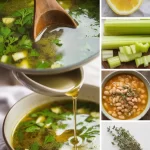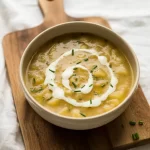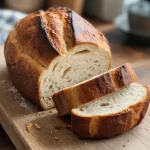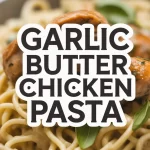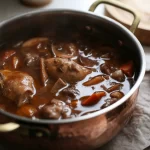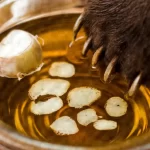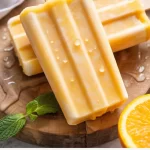I absolutely love this recipe because it’s the perfect blend of creamy custard and rich caramel, creating a decadent dessert that feels like a warm hug in every bite. Plus, the process of making it is such a satisfying experience—watching sugar transform into caramel and savoring the anticipation as it chills in the fridge makes the whole journey deliciously worth it!

My Classic Crème Caramel mixes a silken blend of 2 cups of whole milk and 1 cup of heavy cream with the rich caramel made from 1 cup of granulated sugar. Five large eggs and a hint of vanilla extract finish this decadent dessert treat.
Ingredients

Sugar granules: Provide sweetness and caramelization; add richness.
Whole milk: Critical for a smooth consistency; includes carbs, protein, and calcium.
Cream that is heavy: imparts richness and smoothness; is very high in fat.
Vanilla extract: Boosts taste; fragrant and adds complexity.
Key for setting custard, eggs are rich in protein and nutrients.
Enhances flavor balance and is key for contrasted sweetness: salt.
Ingredient Quantities
- 1 cup (200g) granulated sugar
- 1/4 cup (60ml) water
- 2 cups (480ml) whole milk
- 1 cup (240ml) heavy cream
- 2 teaspoons vanilla extract
- 5 large eggs
- 1/2 cup (100g) granulated sugar
- Pinch of salt
Instructions
1. Set your oven to 325°F (160°C) to heat.
2. In a medium saucepan, combine 200 grams of granulated sugar and 60 milliliters of water. Stir the mixture until the sugar dissolves, then stop stirring. Allow the mixture to boil until it reaches a deep amber color.
3. Pour the caramel into a 9-inch (23 cm) round baking dish that you can use for baking, and tilt the dish so the caramel coats the bottom of it evenly. Let it cool and harden.
4. In a different saucepan, mix 2 cups (480ml) of whole milk with 1 cup (240ml) of heavy cream. Heat over medium until it starts steaming, then take it off the burner. Mix in 2 teaspoons of vanilla extract.
5. In a big bowl, combine 5 whole eggs, 1/2 cup of granulated sugar (100g), and a little salt. Whisk until smooth.
6. Gradually add the warm milk mixture to the egg mixture, whisking all the while to keep the eggs from scrambling.
7. Pour the custard through a fine-mesh sieve to exclude any particles of cooked egg.
8. Strain the custard and pour it into the baking dish that you have coated with caramel.
9. Put the baking dish into a bigger roasting pan and fill the outer pan with water that’s really hot—so hot that it would scald you—to a depth halfway up the sides of the baking dish.
10. Place in the preheated oven at 350°F for 45-50 minutes, or until the edges are set and the center wobbles slightly. Cool completely. Refrigerate for at least 4 hours or overnight. To serve, run a knife around the edge, and invert onto a serving plate.
Equipment Needed
1. Oven
2. Medium saucepan
3. Large saucepan
4. 9-inch (23 cm) round baking dish
5. Large bowl
6. Whisk
7. Fine-mesh sieve
8. Roasting pan
9. Measuring cups and spoons
10. Kitchen scale (for measuring grams)
11. Knife (for serving)
12. Serving plate
13. Heat-resistant gloves or pot holders
FAQ
- Q:May I opt for another variety of milk in this recipe? A: If you want the best texture and flavor from this recipe, you will have to stick with whole milk. However, if you must, you can switch it with 2% milk. Non-dairy milk might really throw the taste and custard set off, so we don’t recommend any of those.
- Q:How do I prevent the caramel from burning?
A: Combine sugar and water in the saucepan. Place over medium heat, and allow the mixture to come to a boil. Stir it frequently as the mixture heats up. When it reaches a constant boiling state, stop stirring and watch the boiling closely. As soon as the sweet liquid turns a deep amber color, take it off the heat. - Q:What is the best way to avoid bubbles in the custard?
B: Whisk the eggs with the sugar very lightly. You don’t want to incorporate any air that will make the flan puff up. When the eggs and sugar are mixed well, strain the mixture to ensure a completely smooth custard. Then pour the strained custard into the caramel-lined ramekins. - Q:Is it permissible to prepare creme caramel in advance? A: It is indeed permissible; this dish can be assembled a day ahead of time. Refrigerate it until you are ready to serve.
- Q:How can I tell when the creme caramel is finished baking? A: The custard should be set at the edges but have a slight wobble in the center. If you shake it gently, you should see a slight rocking motion in the center. It will firm up even more when cooled and, in my case, was unbelievably delicious.
- Q:Can a bigger batch be made? A: Yes, the recipe can be doubled, and the mixture can be shared between more ramekins. You’ll need to adjust the baking time, though; the rule of thumb is to add 15 minutes to the time when using twice as many dishes.
Substitutions and Variations
The following are some alternatives for the Classic Crème Caramel:
Whole milk: For a lighter version, you can use 2% milk or a mix of 1 cup half-and-half and 1 cup skim milk.
Coconut cream or a combo of 3/4 cup whole milk and 1/4 cup melted unsalted butter can stand in for heavy cream. These substitutes yield a similar richness and consistency that make them excellent alternatives in most recipes calling for heavy cream.
Vanilla extract: For a more intense vanilla flavor, use either 1 vanilla bean, split with seeds scraped out, or 2 teaspoons of vanilla paste.
Pro Tips
1. Caramel Consistency: When making the caramel, swirl the saucepan gently instead of stirring once the sugar has dissolved. This helps prevent crystallization and ensures a smooth caramel.
2. Egg Tempering: To avoid scrambling the eggs, add the hot milk and cream mixture to the eggs very slowly, a little at a time, while whisking constantly. This process, known as tempering, gradually raises the temperature of the eggs.
3. Strain for Smoothness: Straining the custard mixture through a fine-mesh sieve before baking is crucial. This step removes any bits of cooked egg and ensures a silky texture.
4. Water Bath Precision: Use an oven thermometer to ensure your oven is at the right temperature, and place a kitchen towel at the bottom of the roasting pan before adding water. This helps prevent the baking dish from sliding and encourages even cooking.
5. Doneness Check: Gently shake the baking dish to check doneness. The custard should be set on the edges but still jiggle slightly in the center. It will continue to cook as it cools, resulting in a perfectly creamy texture.

Classic Creme Caramel Recipe
My favorite Classic Creme Caramel Recipe
Equipment Needed:
1. Oven
2. Medium saucepan
3. Large saucepan
4. 9-inch (23 cm) round baking dish
5. Large bowl
6. Whisk
7. Fine-mesh sieve
8. Roasting pan
9. Measuring cups and spoons
10. Kitchen scale (for measuring grams)
11. Knife (for serving)
12. Serving plate
13. Heat-resistant gloves or pot holders
Ingredients:
- 1 cup (200g) granulated sugar
- 1/4 cup (60ml) water
- 2 cups (480ml) whole milk
- 1 cup (240ml) heavy cream
- 2 teaspoons vanilla extract
- 5 large eggs
- 1/2 cup (100g) granulated sugar
- Pinch of salt
Instructions:
1. Set your oven to 325°F (160°C) to heat.
2. In a medium saucepan, combine 200 grams of granulated sugar and 60 milliliters of water. Stir the mixture until the sugar dissolves, then stop stirring. Allow the mixture to boil until it reaches a deep amber color.
3. Pour the caramel into a 9-inch (23 cm) round baking dish that you can use for baking, and tilt the dish so the caramel coats the bottom of it evenly. Let it cool and harden.
4. In a different saucepan, mix 2 cups (480ml) of whole milk with 1 cup (240ml) of heavy cream. Heat over medium until it starts steaming, then take it off the burner. Mix in 2 teaspoons of vanilla extract.
5. In a big bowl, combine 5 whole eggs, 1/2 cup of granulated sugar (100g), and a little salt. Whisk until smooth.
6. Gradually add the warm milk mixture to the egg mixture, whisking all the while to keep the eggs from scrambling.
7. Pour the custard through a fine-mesh sieve to exclude any particles of cooked egg.
8. Strain the custard and pour it into the baking dish that you have coated with caramel.
9. Put the baking dish into a bigger roasting pan and fill the outer pan with water that’s really hot—so hot that it would scald you—to a depth halfway up the sides of the baking dish.
10. Place in the preheated oven at 350°F for 45-50 minutes, or until the edges are set and the center wobbles slightly. Cool completely. Refrigerate for at least 4 hours or overnight. To serve, run a knife around the edge, and invert onto a serving plate.





